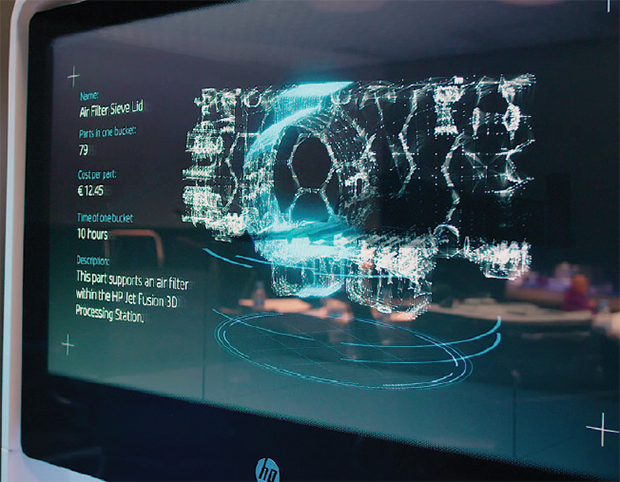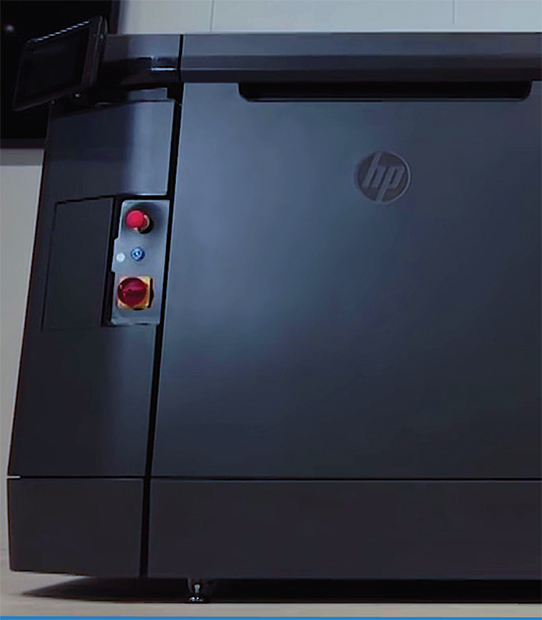HP and Jabil Aim to Transform Manufacturing with 3D Printing Solutions

Image courtesy of HP and Jabil.
Latest News
May 1, 2018
Challenges
- Strong manufacturing expertise was required to drive adoption of additive manufacturing for production parts.
- Manufacturing rigor and process discipline required to validate technology and break-even analyses.
- End-to-end process control and supply chain expertise were paramount in ramping delivery of production-quality parts at scale.
Solution
- Jabil’s additive manufacturing expertise enables HP and other customers to improve final product design and development.
- Jabil currently produces 50 parts for HP printers.
- Jabil’s manufacturing capabilities simplify and speed production of HP’s expanding printer portfolio.
Benefits
- HP’s Jet Fusion 3D Printing system lowers time-to-market and cost barriers with fast and cost-effective manufacturing at scale.
- Design flexibility offers new levels of freedom in designing and making products
- HP’s 3D printing ecosystem drives success for innovation partners as volume production ramp intensifies.
Driving Digital Transformation
HP invented the commercial laser printer in 1980 and followed with the first thermal inkjet printer four years later. These breakthroughs transformed the printing industry and established HP as a major game-changer. Since then, the company’s record of industry firsts continues to grow, typified by its motto to “keep reinventing.”
This keen focus on reinvention sharpened in 2016 when HP shipped its first production units of HP’s Jet Fusion 3D Printing System in North America—to Jabil’s Blue Sky Innovation Center in San Jose, CA. Heralded as a major step in bringing disruptive, digital manufacturing solutions to market, HP’s 3D printing technology promises speed, quality and cost savings to transform how products are designed and made.
 Image courtesy of HP and Jabil.
Image courtesy of HP and Jabil.“If we’re really going to transform the $12 trillion manufacturing industry, we can’t do it on our own,” says Stephen Nigro, president of 3D printing, HP. “We embraced a different development model, so others can innovate in spaces where they have a point of view and expertise in high-volume manufacturing. In terms of foresight and thinking, Jabil was way ahead.”
Revolutionizing an industry like manufacturing is a tall order for any one company, according to John Dulchinos, VP of Digital Manufacturing, Jabil. “What it really takes is an end-to-end solution,” he says. “We really appreciate HP’s open approach because it’s inclusive and leverages a full partner ecosystem.”
Wanted: Partners in Innovation
HP’s vision for transforming manufacturing is guided by a series of business imperatives, starting with a technology roadmap to ensure the highest levels of product quality, consistency and reliability. “We built a value chain of innovators,” recalls Virginia Palacios, director of Strategic Customer Engagement, HP. “We wanted to partner with the best—in software, materials and manufacturing—so we could extend the number of applications and use cases to really explode the market. Jabil is a great partner; they know what it takes to scale manufacturing.”
What stood out most about Jabil was its long-running partnerships with scores of market leaders in a variety of industry sectors. “Jabil’s work across lots of industries provided unique insight into particular customer needs,” Palacios adds. “Jabil’s engineers had all the data at their fingertips to help us understand where we could make a difference as well as where it made sense economically to use 3D printing instead of traditional manufacturing methods.”
Equally important was Jabil’s vision of how 3D printing could accelerate the digital transformation taking place in manufacturing. “In a traditional manufacturing environment, you make and move fixtures and tooling through a set of discrete processes,” says Dulchinos. “With additive manufacturing, you put materials into the printer, eliminating that additional time and cost. We immediately saw the potential to create a supply chain of the future where production could be moved from one location to the next by shifting a digital file.”
Manufacturing Rigor Moves 3D Printing Forward
In addition to its early interest in additive manufacturing, Jabil was well positioned to work with HP based on a long and successful partnership. “We have a lot of confidence in Jabil because of our history,” says Nigro. “But it was their commitment and vision that led to Jabil becoming an HP MJF (Multi Jet Fusion) foundational partner. In fact—they called us!” In that pivotal role, Jabil helped HP validate its technology as teams of engineers worked together in Barcelona and Jabil’s Blue Sky Innovation Center in San Jose. “It was a real collaborative effort,” says Palacios. “Jabil’s production, quality and supply chain experience provided great input for developing the printer, ensuring part quality and getting us ready for manufacturing.”
 Image courtesy of HP and Jabil.
Image courtesy of HP and Jabil.Moreover, Jabil’s team embodied the strict discipline needed to develop rigorous end-to-end process control capabilities for ensuring the highest levels of part finishing and quality required by the manufacturing industry. “One of our ‘ah-ha’ moments came from Jabil explaining that post-processing is a mandatory step in finishing parts,” adds Palacios. “Even parts produced using injection molding go through this vital process. Jabil offered a much deeper understanding of what was needed from a manufacturing perspective.”
Jabil applied manufacturing rigor to part design, testing, validation and final qualification, which enabled HP to integrate continuous quality improvements into its development processes.
“As a large manufacturer, we have a sophisticated knowledge of processes and materials that allows us to do things others can’t,” notes Dulchinos. “Together, Jabil and HP got a tremendous head start in determining how to make production-grade, 3D printed parts at scale.”
Print the Printer
To demonstrate 3D printing’s readiness for manufacturing, HP and Jabil applied its early learning to expedite the production ramp of the Jet Fusion 3D Printing System. After proving that certain 3D printed parts met precision, property and strength requirements for specific applications, the team evaluated the difference in production costs using 3D printing instead of traditional injection molding for the volumes desired.
“We saw breakeven points climb from 5,000 units to 20,000, 30,0000, up to 40,000 units,” says Dulchinos. “We’ve also gone through 19 design iterations for a part in the time it would take us to do one with traditional manufacturing methods. This speeds time-to-market and saves a considerable amount of money, which confirmed our belief that 3D printing is ready for manufacturing applications.”
In terms of tangible cost savings, Jabil helped HP realize that a $20 printer part made using traditional manufacturing methods could be produced with MJF for less than $6 while being 70% lighter. In addition to lowering time-to-market and cost barriers, HP has gained significant design flexibility. Components that once had to be separated into sub-parts with different screws and assembly requirements now can be produced as a single, 3D printed part.
“It’s possible to achieve 5X cost savings when you integrate functionality,” notes Nigro. “And, when you start eliminating assembly costs, that’s where you really can pick up big savings.”
To date, Jabil is manufacturing more than 50 production-quality parts for HP’s MJF and other printers while qualifying additional parts for volume manufacturing. “We really trust Jabil’s supply chain experience,” Palacios asserts. “They can decide when and where to produce parts in a distributed manufacturing environment. We’re assured the part will arrive on time, to the right line, to meet our manufacturing needs.”
Think, Design and Make Differently
Jabil is leveraging early momentum to help expand the use of 3D printing across other HP businesses. “We have an ‘HP on HP’ initiative where we’re looking for places to produce 3D printed parts instead of making them with traditional techniques,” Nigro adds.
“Learning cycles are so much faster with 3D printing; it will enable us to think, design and make products differently.”
To that end, Jabil’s additive manufacturing experts are instrumental in explaining how parts need to be designed to achieve desired levels of design flexibility, mechanical integrity and overall part quality. Engineers from both companies continue to collaborate on HP’s MJF technology roadmap to understand and fill current gaps in manufacturing while applying early discoveries to inform the development of materials, processes, machines and future 3D printing capabilities to support ever-increasing customer use cases.
“One of the things we’re really excited about is the scalability of the Multi Jet Fusion technology,” says Palacios. “We will be able to control the properties of our voxel by changing its color, elasticity, connectivity and finish while combining more and different shapes into one part to develop products we have yet to imagine. Jabil can help us bring these new capabilities to market in the upcoming months and years.”
Looking ahead, HP is confident that Jabil’s end-to-end manufacturing solutions and collaborative approach will continue to drive adoption of Multi Jet Fusion technology.
“I would say that by 2021, almost one-third of the parts that Jabil produces could make sense to be 3D printed,” adds Nigro. “Jabil is helping us make our 3D printing ecosystem more successful as we move into volume production. They have a great, high-integrity team of people; it’s a winning combination.”
Together, Jabil and HP are gaining significant ground in revolutionizing manufacturing through the use of innovative, end-to-end 3D printing solutions. “We recently were awarded the contract to manufacture the next-generation HP printer,” concludes Dulchinos. “It’s really exciting to know that we’re helping to ramp up production of a printer we’ll be using in the future to make parts for HP and other customers around the world.”
Subscribe to our FREE magazine, FREE email newsletters or both!
Latest News
Related Topics






